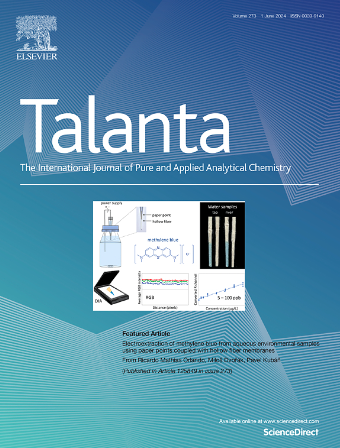毛细管电泳用于植物分析的研究进展
IF 5.6
1区 化学
Q1 CHEMISTRY, ANALYTICAL
引用次数: 0
摘要
毛细管电泳和微芯片电泳在植物和营养性土壤的化学成分分析中发挥着重要作用,在植物生理学、农化、医学、毒理学和食品科学等领域都有广泛的应用。电泳方法用于测定矿物质,如营养物质、重金属离子、初级和次级代谢物、除草剂、植物激素、肽、蛋白质和细胞外囊泡。以下主题的进展尤其明显:1)开发用于现场监测土壤矿物质供应的移动电泳分析仪;2)无需样品处理直接分析木质部SAP; 3)毛细管电泳和微芯片电泳与质谱联用,用于全面的代谢组学和蛋白质组学表征;4)作为具有一系列治疗和毒理学作用的生物活性化合物的次级代谢物的测定;6)植物分泌物、细胞外囊泡和特异性蛋白相互作用的研究。本文章由计算机程序翻译,如有差异,请以英文原文为准。

Advances in capillary electrophoresis for plant analysis
Capillary and microchip electrophoresis plays an important role in the analysis of the chemical composition of plants and nutrient soils, which finds applications in plant physiology, agrochemistry, medicine, toxicology and food science. Electrophoretic methods are used to determine minerals such as nutrients, heavy metal ions, primary and secondary metabolites, herbicides, phytohormones, peptides, proteins and extracellular vesicles. Progress is particularly evident in the following topics: i) development of mobile electrophoretic analysers for field-based monitoring of soil mineral supply, ii) direct analysis of xylem sap without sample treatment, iii) coupling of capillary and microchip electrophoresis with mass spectrometry for comprehensive metabolome and proteome characterization, iv) determination of secondary metabolites as biologically active compounds with a range of therapeutic and toxicological effects, v) monitoring of herbicides and their degradation dynamics, vi) research on plant exudates, extracellular vesicles and specific protein interactions.
求助全文
通过发布文献求助,成功后即可免费获取论文全文。
去求助
来源期刊

Talanta
化学-分析化学
CiteScore
12.30
自引率
4.90%
发文量
861
审稿时长
29 days
期刊介绍:
Talanta provides a forum for the publication of original research papers, short communications, and critical reviews in all branches of pure and applied analytical chemistry. Papers are evaluated based on established guidelines, including the fundamental nature of the study, scientific novelty, substantial improvement or advantage over existing technology or methods, and demonstrated analytical applicability. Original research papers on fundamental studies, and on novel sensor and instrumentation developments, are encouraged. Novel or improved applications in areas such as clinical and biological chemistry, environmental analysis, geochemistry, materials science and engineering, and analytical platforms for omics development are welcome.
Analytical performance of methods should be determined, including interference and matrix effects, and methods should be validated by comparison with a standard method, or analysis of a certified reference material. Simple spiking recoveries may not be sufficient. The developed method should especially comprise information on selectivity, sensitivity, detection limits, accuracy, and reliability. However, applying official validation or robustness studies to a routine method or technique does not necessarily constitute novelty. Proper statistical treatment of the data should be provided. Relevant literature should be cited, including related publications by the authors, and authors should discuss how their proposed methodology compares with previously reported methods.
 求助内容:
求助内容: 应助结果提醒方式:
应助结果提醒方式:


